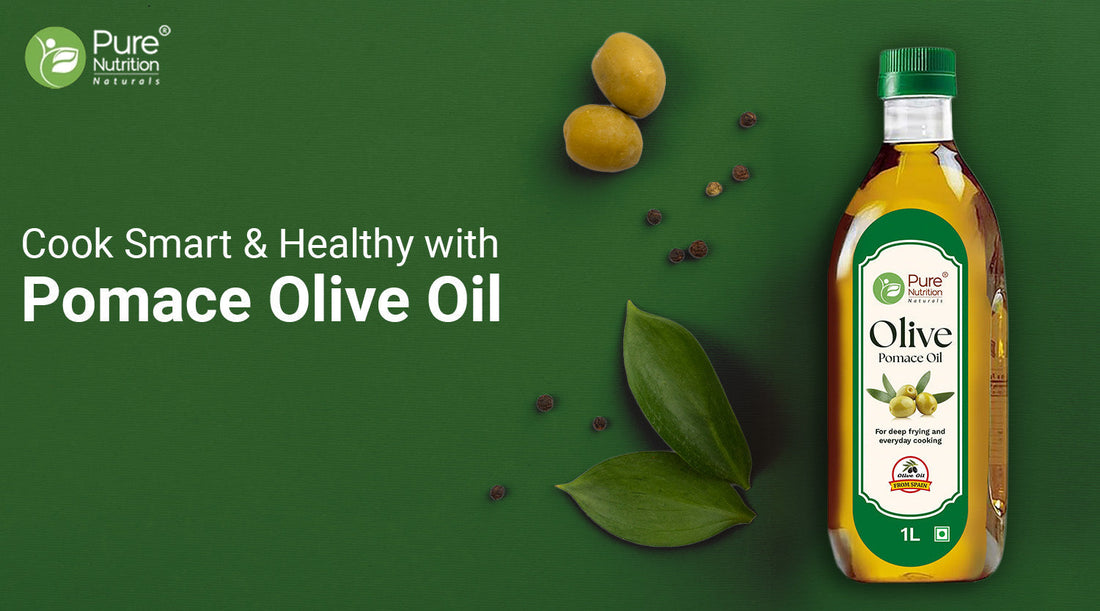
Pomace Olive Oil: The Smart Choice for Healthy, High-Heat Cooking
As a Functional Nutritionist, I'm constantly exploring not just what people eat, but also how their foods function inside the body. And one of the most commonly misunderstood oils that raises eyebrows in nutrition circles is Pomace Olive Oil. While extra virgin olive oil often takes the spotlight in health discussions, pomace olive oil is steadily carving out a place in the kitchen, particularly where high-heat cooking is involved. This article offers a clear, research-backed exploration of pomace olive oil: what it is, how it's made, its benefits, and when it's a smart choice.
What is Pomace Olive Oil?
Pomace olive oil is a type of refined olive oil that is extracted not from whole olives, but from the residual olive pulp left after the initial mechanical pressing used to make extra virgin and virgin olive oil. This pulp still contains small amounts of oil, which can be extracted using solvent extraction methods, followed by refining to ensure safety and stability.
This process of extraction itself differentiates pomace oil from cold-pressed or mechanically extracted oils. Pomace oil is more refined, neutral in flavor, and highly stable at high temperatures, making it ideal for deep frying and large-scale cooking where cost and thermal performance matter.
When compared to:
- Extra Virgin Olive Oil (EVOO): Unrefined, robust in flavor, high in polyphenols and antioxidants, lower smoke point (~375°F / 190°C).
- Virgin Olive Oil: Also mechanically extracted but from slightly riper olives, less flavorful than EVOO.
-
Pomace Olive Oil: Refined, neutral, stable, and more affordable, it still carries many of the fatty acid benefits associated with olive oils.
What Are the Benefits of Pomace Olive Oil?

1. High Smoke Point
Pomace olive oil boasts a smoke point of approximately 460°F (238°C), significantly higher than EVOO. This makes it ideal for deep frying, sautéing, and baking, where thermal degradation of other oils can lead to the formation of harmful aldehydes.
2. Rich in Oleic Acid
As per research conducted in 2010, pomace olive oil still contains a very good amount of oleic acid, a monounsaturated fat known for its role in reducing LDL cholesterol, improving insulin sensitivity, and supporting cardiovascular health.
3. Antioxidant Content
While not as rich in polyphenols as EVOO, pomace olive oil retains traces of Vitamin E and squalene, both of which are lipid-soluble antioxidants that contribute to cell membrane stability and anti-aging properties.
4. Extended Shelf Life
Due to its refined structure and lower moisture content, pomace olive oil resists oxidation and rancidity better than unrefined oils, making it more shelf-stable which is an important consideration for commercial kitchens.

What Are Common Uses of Pomace Olive Oil?
Culinary Uses:
- Deep frying: High heat tolerance means food cooks evenly without oil breakdown.
- Baking: Neutral flavor doesn’t interfere with baked goods.
- Food manufacturing: Common in processed foods due to cost-effectiveness and heat stability.
Non-Culinary Uses:
- Soap production: Works as a mild base oil for soaps and detergents.
- Cosmetic formulations: Used in lotions, massage oils, and body creams as an emollient.
Myth-Busting: Setting the Record Straight About Pomace Olive Oil
Several myths surround pomace olive oil, but science paints a different, more positive picture. One common myth is that pomace olive oil isn’t suitable for sautéing or frying. In reality, due to its high smoke point, pomace olive oil is actually more suitable than extra virgin olive oil (EVOO) for these high-heat cooking methods. Another myth is that pomace olive oil holds no health value. However, research shows it contains significant amounts of oleic acid—a heart-healthy monounsaturated fat—and traces of Vitamin E, offering real nutritional benefits. Some people also believe that pomace oil is chemically unsafe because it is extracted using solvents. In truth, the refining process removes all solvent residues, resulting in a safe, food-grade oil that meets strict regulatory standards.
Finally, the misconception that pomace olive oil cannot withstand heat is incorrect; it is one of the most heat-stable oils available, standing just behind avocado oil and rice bran oil according to several studies. These facts clearly show that pomace olive oil is not only safe but also highly functional for everyday use.
How Does Pomace Olive Oil Compare to Other Olive Oils?

When comparing pomace olive oil to extra virgin or virgin olive oils, several important differences emerge. First, in terms of extraction, extra virgin and virgin olive oils are produced by mechanical pressing, whereas pomace olive oil is extracted from the remaining olive pulp using solvents and then refined. Although this process lowers its natural antioxidant content, pomace olive oil still retains healthy oleic acid levels and traces of vitamin E. It offers a much longer shelf life compared to extra virgin olive oil, making it practical for bulk use. While extra virgin olive oil is celebrated for its rich polyphenols and robust flavor, pomace olive oil provides a neutral taste, which is ideal when the flavor of the oil should not overpower a dish. It is also significantly more affordable—typically 30–50% cheaper—making it accessible for larger households, restaurants, and food industries.
With a higher smoke point than extra virgin olive oil, pomace olive oil is far superior for deep frying, roasting, and high-heat cooking. In short, pomace olive oil offers durability, neutrality, and affordability without completely compromising on nutritional quality.
|
Feature |
Extra Virgin Olive Oil |
Pomace Olive Oil |
|
Extraction Method |
Cold-pressed |
Solvent + refining |
|
Antioxidants |
High (polyphenols) |
Low (Vitamin E traces) |
|
Smoke Point |
~375°F (190°C) |
~460°F (238°C) |
|
Taste |
Robust, fruity |
Neutral |
|
Cost |
High |
Moderate / Low |
|
Shelf Life |
Moderate |
Longer |
Pomace olive oil may not be the star in raw salads or dips like EVOO, but it shines in practicality. For people looking for a cost-effective, health-conscious, heat-stable cooking fat, it’s a functional winner.
When Should You Choose Pomace Olive Oil?
- When deep frying, stir-frying, or roasting at high temperatures.
- In commercial kitchens or large families where affordability meets volume cooking.
- When the recipe calls for neutral-tasting oil that doesn’t alter the dish’s profile.
-
In baked goods, where the structure of the oil is more important than taste.
Conclusion: So Should You Use Pomace Olive Oil?
Absolutely, if used for the right purpose.
While pomace olive oil doesn’t carry the full antioxidant spectrum of extra virgin olive oil, it remains a safe, versatile, and economical oil that supports heart health due to its high oleic acid content. It doesn’t deserve the stigma often attached to it. As a Functional Nutritionist, I recommend keeping a variety of oils in your pantry, each with its own strengths.
If your goal is to build a sustainable, budget-friendly, heart-smart kitchen that doesn’t compromise on safety or function during high-heat cooking, pomace olive oil earns its place on your shelf.
It's all about managing oil rotation and the amount of oil you use. After all, even turmeric is said to be unsafe above a limit, isn't it?
Choose Pure Nutrition’s Pomace Olive Oil — perfect for high-heat cooking, heart health, and everyday kitchen needs.
FAQS
1.Is pomace olive oil healthy?
Pomace olive oil offers a good amount of healthy fats, but it’s more refined than extra virgin olive oil. While suitable for cooking, it has fewer antioxidants and nutrients compared to less processed varieties.
2.Can pomace olive oil be reused in frying?
Yes, pomace olive oil has a high smoke point, making it stable for deep frying and suitable for multiple uses. However, it’s best to reuse it just a few times to maintain quality and health benefits.
3.Does pomace olive oil affect taste?
Pomace olive oil has a very mild flavor compared to extra virgin olive oil. It doesn’t overpower dishes, making it ideal when you want a neutral taste, especially in fried or sautéed recipes.
4.Is pomace olive oil beneficial for skin care?
While not as nutrient-rich as extra virgin olive oil, pomace olive oil still moisturizes the skin effectively. It can soften dry patches and protect the skin barrier but offers fewer antioxidants for deeper repair.
5.Is pomace oil good for Indian cooking?
Absolutely! Pomace olive oil’s high smoke point and neutral flavor make it a versatile choice for Indian cooking, from deep-frying samosas to sautéing curries, without altering traditional tastes.


